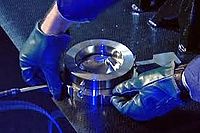Burst Discs
Burst Discs, also known as Rupture Discs, is a non-reclosing pressure relief device that, in most uses, protects a pressure vessel, equipment or system from overpressurization or potentially damaging vacuum conditions. A rupture disc is a type of sacrificial part because it has a one-time-use membrane that fails at a predetermined differential pressure, either positive or vacuum. The membrane is usually made out of metal,[1] but nearly any material (or different materials in layers) can be used to suit a particular application. Rupture discs provide instant response (within milliseconds) to an increase or decrease in system pressure, but once the disc has ruptured it will not reseal. Major advantages of the application of rupture discs compared to using pressure relief valves include leak-tightness and cost.
Burst discs are widely accepted throughout industry and specified in most global pressure equipment design codes (ASME, PED, etc.). Rupture discs can be used to specifically protect installations against unacceptably high pressures or can be designed to act as one-time valves or triggering devices to initiate with high reliability and speed a sequence of actions required.
Application
- petrochemical
- aerospace
- aviation
- defense
- medical
- railroad
- nuclear
- chemical
- pharmaceutical
- food processing
- oilfield
